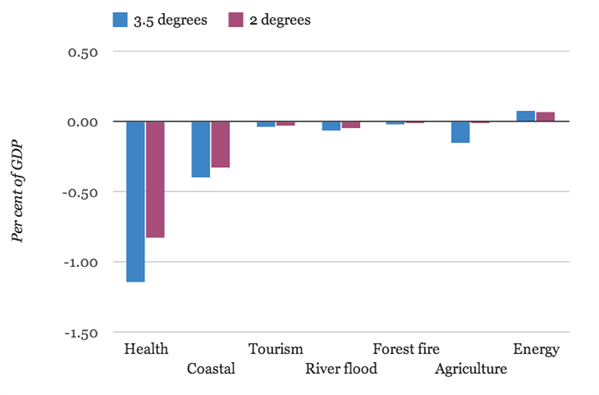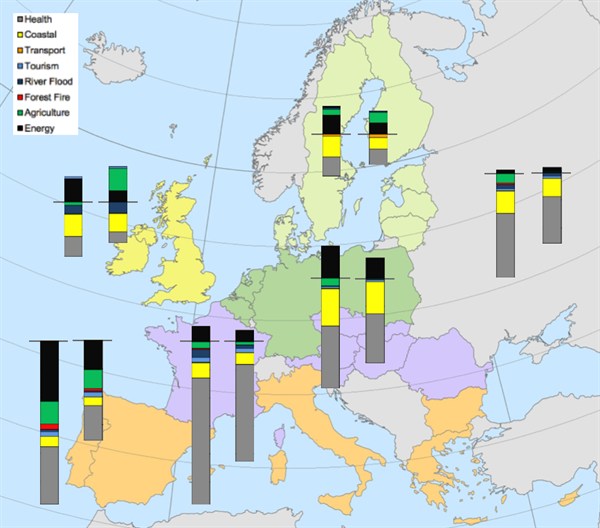Carbon Brief Staff
26.06.2014 | 5:00pmThe European economy would be €190 billion smaller at the end of the century, equivalent to 1.8 per cent of current annual GDP, if nothing more is done to tackle climate change. So says the European Commission’s Joint Research Centre (JRC).
But the damage caused by 3.5 degrees of warming above pre-industrial temperatures – the level of warming expected by the 2080s under business as usual – would be uneven. Some sectors and some parts of Europe would face less severe impacts than others. We’ve taken a look at the distribution of predicted damages.
Calculating damages
The JRC scientists have used the latest models and climate data to assess what the likely impacts of rising temperatures, changing rainfall patterns and sea level rise will be on different parts of the economy.
This new study used separate models to estimate impacts on agriculture, tourism, health, coastal damage, river flooding, forest fires, transport and energy use. Then it assigned a monetary value to those impacts in a single economic model to work out the overall cost of climate damages.
To get an idea of how big or small the number is, the costs are expressed as a percentage of GDP – the market value of all recognised goods and services produced in a year. But the price tag put on climate change doesn’t include everything.
Some aspects aren’t well enough understood yet, such as the consequences of abrupt climate change, or are difficult to assign a monetary value to – such as the loss of natural ecosystems and the services they provide like clean air, clean water or carbon storage.
Accounting for these extra factors is likely to mean higher rather than lower costs, according to a report earlier this year by the Intergovernmental Panel on Climate Change.
On the other hand, estimates of how much climate change could cost us also don’t generally include how adaptation measures, such as changing farming practices or reducing water use, could make us more resilient against damages.
The JRC’s study also ignores the effects of rising populations and growing economies. These effects would tend to increase the costs of warming too, it says, by increasing the number and value of assets exposed to climate change damage.
There’s lots of work going on to try to account for these things, but for the time being it’s important just to recognise they’re largely missing from cost calculations.
What and where will be hardest hit?
The headline figure of €190 billion in climate damages across Europe is not evenly spread. And if the world were to take action to limit warming to 2 degrees above pre-industrial levels it would be reduced by about a third, down to €120 billion.
The biggest climate damages are expected to be on human health and on our coasts, as the chart below shows. Negative impacts on crop yields would also be significant but would almost disappear if warming were limited to 2 degrees.

Source: Joint Research Centre. Graph by Carbon Brief.
The impacts on health include things like heat stress during heatwaves, increased rates of food- and water-borne diseases and respiratory problems. Coastal effects are mainly related to sea level rise and flooding.
The study also found small economic benefits as temperatures rise in terms of reduced energy needs. That’s because cold northern parts of Europe would need less heating, more than offsetting extra energy use for air conditioning in southern Europe.
There are big geographical differences for each type of climate damage. We’ve put the report’s data onto a map, below, to illustrate the point. The coloured bars show climate damages in terms of GDP for each region of Europe with benefits above the line and costs underneath.
In each region the left hand bars are for 3.5 degrees of warming and the right hand bars for 2 degrees. The combined impact for all regions across Europe is shown in the bars floating above Russia.

Source: Joint Research Centre. Composite map with graphs by Carbon Brief.
On balance the UK, Ireland and Scandinavia will suffer relatively minimal net climate damages, the study suggests. It’s important to remember the missing costs we discussed above, however.
But the further south you go the bleaker the picture gets. In countries like Italy and Spain there are no positives: climate damages across all types of impact mount up, most significantly in terms of health, agriculture and energy use for cooling.
Europe as a whole would face net climate damages equivalent to 1.8 per cent of GDP under 3.5 degrees of warming – the €190 billion headline figure. If there is global action to limit warming to 2 degrees that would be reduced, but significant impacts will remain.

